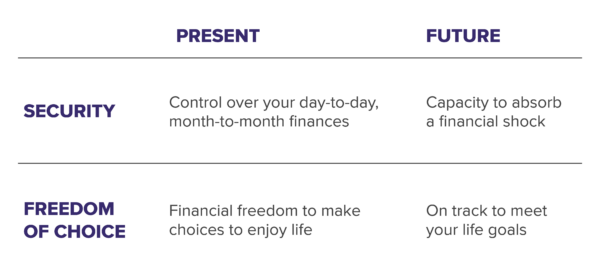
By Ryan Ashton

In this second post in a 4 part series, we spend some time looking at the role of employee wellness as part of a broader employee benefits program. You can read part 1 here.
When discussing employee benefits, a question to ask off the top is, ‘what is financial wellness or well-being?’
When we consider the idea of physical health, it goes beyond not simply being sick. It extends to how we feel, our energy levels, or how easily we can participate in the activities we want. Being financially well is no different.
The Consumer Financial Protection Bureau (CFPB) defines financial well-being as “having financial security and financial freedom of choice, in the present and in the future1” with the following four categories:

In the not-so-distant past, when organizations considered ‘wellness’ in the context of employee benefits, they all gravitated towards physical wellness – initiatives like exercise or fitness stipends, smoking cessation, or weight loss programs.
And then there was the onset of much-needed mental wellness programs, and companies increased their investment in employee assistance programs designed to address mental health, in addition to physical health, with new technologies and apps to provide individual support.
Now we enter the realm of financial wellness. As organizations realize that all aspects of wellness – inclusive of physical, mental and financial – play a major role in overall employee wellbeing, they’re beginning to take a more holistic look at benefits programs, and creating comprehensive packages that try to address all three of these to have an overall positive net effect on employee health.
Consider the employee that is constantly worried about paying bills or concerned that they won’t get their paycheck before a rent or mortgage payment is due. Certainly, their financial well-being suffers. But the anxiousness they feel can be overwhelming and affect their mental health. Even more, that psychological stress can lead to negative physical implications.2
And financial stress creates compounding issues for employees and employers. Financial stress alone is reported to cost employers $2,169 per employee per year in productivity and absenteeism.3 If employees can’t perform their jobs or perform them well, they face disciplinary actions or being let go — which further escalates their financial difficulties.
As you consider your own employee financial wellness programs for 2023, earned wage access is likely to be on the list. To help you on your search, we’ve developed this 2023 Earned Wage Access Buyers Guide to help make the decision-making process a little easier.
You can download it here, or visit our website at instant.co to learn more about Instant’s comprehensive suite of fee-free on-demand pay solutions.
1 “Why Financial Well-Being?” Consumer Financial Protection Bureau, www.consumerfinance.gov/consumer-tools/financial-well-being/about. Accessed June 7, 2022.
2 “Managing Stress To Control High Blood Pressure.” www.Heart.Org, June 8, 2021, www.heart.org/en/health-topics/high-blood-pressure/changes-you-can-make-tomanage-high-blood-pressure/managing-stress-to-control-high-blood-pressure.
3 “Lowering the Cost of Financial Stress to Employers and Its Impact on Workers.” Retirement.Johnhancock.Com, Nov. 24, 2020, www.retirement.johnhancock.com/us/en/ viewpoints/financial-wellness/lowering-the-cost-of-financial-stress-to-employers-andits-impac.


